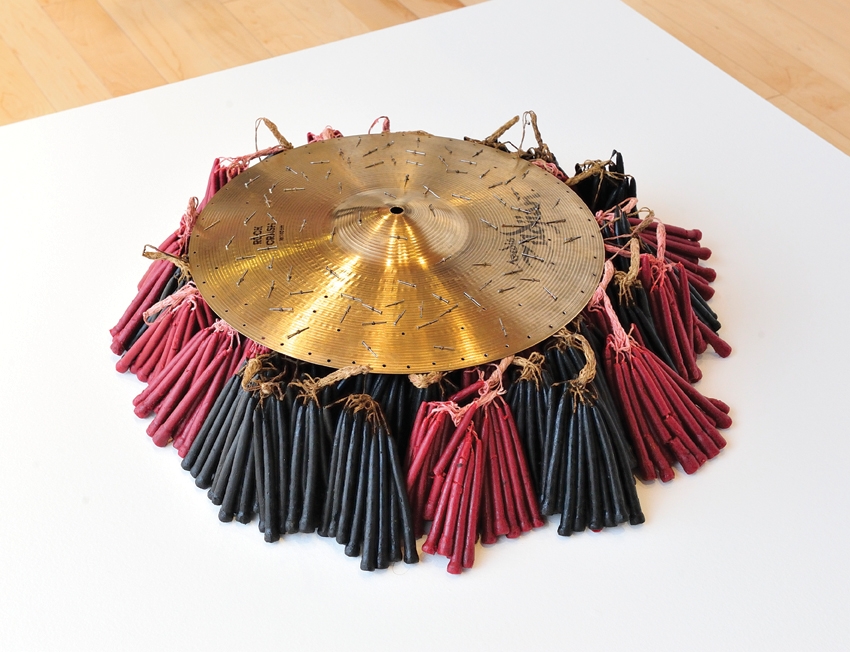Abraham Cruzvillegas’s The Autoconstrucción Suites is spontaneous, unstable, contradictory – no coincidence then that in the near-decade that Cruzvillegas has been working on this series of works or accumulations, some are also titled Autodestrucción, or Demolición. The exhibition, curated by Clara Kim, has travelled from the Walker Art Center in Minneapolis – where it was shown in 2013, also curated by Kim – and is the most complete display of works by Cruzvillegas thus far, not to mention his largest show in Mexico. The Museo Jumex in Mexico City houses half of it, including the aforementioned Demolición (2014), a site-specific performance for this iteration of the show, in which two Huasteco musicians dance a traditional zapateado to their adaptation of the eponymous tune by the Peruvian proto-punk band Los Saicos. In the city of Puebla, meanwhile, the Museo Amparo is home to the other half, with the addition – the show itself is in perpetual construction! – of a new large installation piece in the courtyard, titled Reconstrucción del retrato de mi gemelo cholulteca, perdido por siglos en los lodazales de Cladh Hallan, con un simultáneo parecido a Germán List Arzubide y a Vicente Lombardo Toledano, pero con dos botellas de coñac (or something like Reconstruction of the Portrait of My Cholultec Twin, Lost for Centuries in the Cladh Hallan Bog, with a Simultaneous Likeness to Germán List Arzubide and Vicente Lombardo Toledano But with Two Bottles of Cognac, 2014), which Cruzvillegas created in collaboration with local students.
Cruzvillegas’s process and work have been read as ongoing autobiography (the concept of autoconstrucción itself stemming from his childhood home and neighbourhood, where peasant migrant families built their own houses from whatever materials they could find), and they also function archaeologically as a series of objects meant to reveal something about a culture, not just about the artist himself. Like Mexico (or Korea, or Scotland, where many of the works were made), they have a feel that is both archaic and modern, dirty and neat – the artworks discreetly reveal the story of a place and time, if one pays attention. And the objects that make up those works themselves are about as heterodox as Cruzvillegas’s sense of fashion – one day a traditional Mexican shirt with Japanese construction worker pants, the next a reggaeton-style favela sports jersey with a herringbone jacket. The idiosyncratic choice of ingredients he adds to the mix – mostly found things, dare I call them readymades, or readyunmades? – make up a body of work that is very singularly Cruzvillegean; a new language.
I have worked translating texts about Cruzvillegas’s work, some by the artist himself, and written texts like this one, inspired by his work as well, so I am familiar with many. But several had never before been seen in Mexico, and their physical presence, their delicateness and the equilibrium between their fragility and their simplicity in conjunction with a feeling of rawness are truly moving (cf. La Curva, 2003, to mention just one). And just as it is hard to describe the feeling of someone’s home by, say, looking at photographs in an architectural magazine, it is very difficult to convey the sense of space, homeliness and warmth of Cruzvillegas’s pieces unless you’ve experienced being in them or with them. Because you are in them, part of them – these works are not just sculptures to be observed from a distance. They are texts, contexts, textures, music pieces, plays, movies, sculptures, blocks of colour – a system, a code, a way of life to be experienced, a palpable feeling of communion where the Mexican saying applies: mi casa es su casa, and so my mess is yours too.
Read our feature on Abraham Cruzvillegas, from the January & February 2013 issue.
This article was first published in the March 2015 issue.
